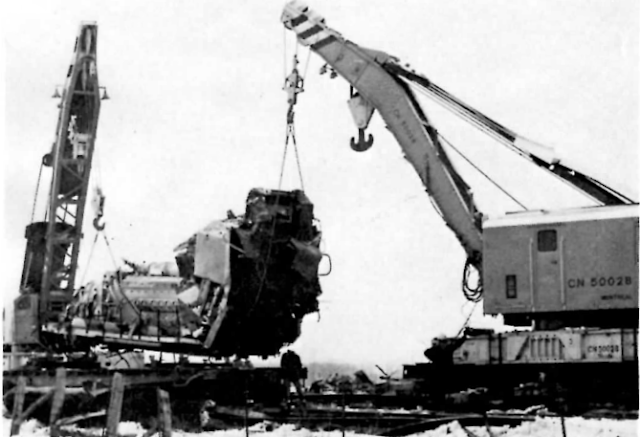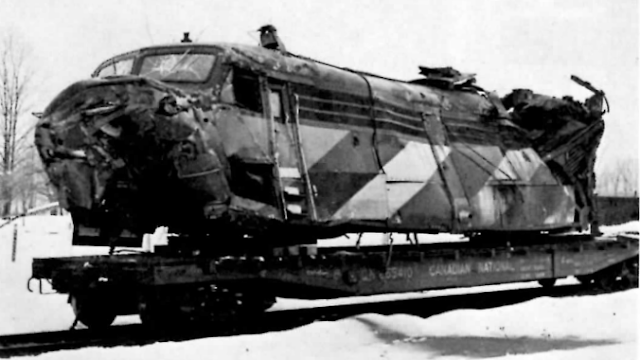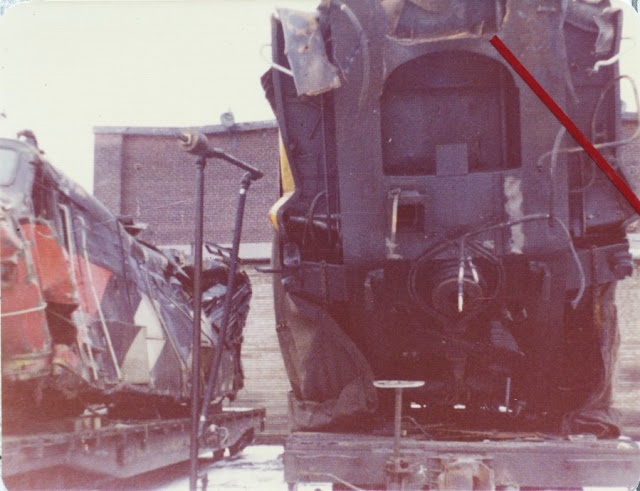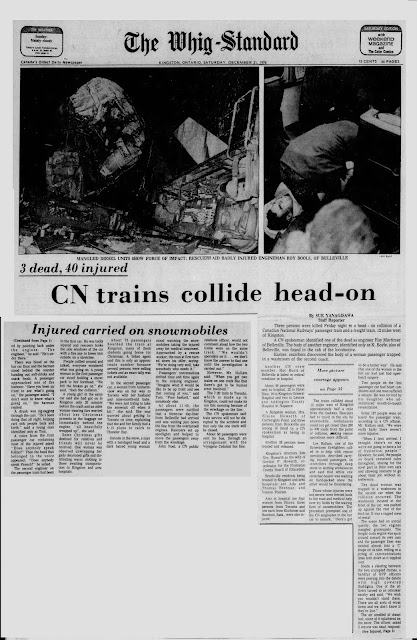In this postscript to my initial post, I'll be profiling the derailment clean-up, the state of the wrecked equipment and a brief epilogue. Having profiled the December 20, 1974 Ernestown collision between eastbound CN freight train 318 and westbound CN passenger train No 45, I received photos taken at the scene from two fellow rail enthusiasts to include in this postscript. From the investigation report I read, I have included a timeline of the clean-up plus photos taken by CN as part of documenting the railway's investigative process. I've also included contemporaneous press accounts from our local newspaper. Some details and facts have been excluded from the initial post, and they will not be included in this post either, for reasons I summarize at the end of this post.
THE DERAILMENT CLEAN-UP
Thirty-five cars of No 318's train were removed from the tail-end at 0150 December 21 westward to Belleville. The two box cars near the head-end were moved clear of the tracks by the Toronto auxiliary in the darkness. The second gondola was rerailed at 0830 and removed also by the Auxiliary. Then, econd engine 9466 was started and used to push the two gondolas west at walking speed to the business track on the south side, opposite Ernestown station. The intense search for 318's engineer continued with the mobile crane coming forward at 0945 but unable to move 9487. The Toronto auxiliary returned at 1045 on the north track. The Montreal auxiliary in the service track, and the mobile crane on the south track were able to reposition 9487, and the body was finally found at 1100, still at the controls, though the head-end trainman had jumped clear. Then, 9487 was positioned south of the south track at 1200.
The south main track was clear by 1730 on December 21 and had a slow order of 15 mph applied. The north track was clear by 1750 though non-existent for about 90 feet east of the estimated point of impact, rebuilt and returned to service by 0115 December 22. CN 6860 had been moved clear of the north track by both auxiliaries at 1710 and 6792 at 1740. Both auxiliaries cleared for the night in the service track by 2100.
On Sunday, December 22 a work extra called at Belleville brought gondolas and flat cars east, and at 0700 on Sunday the 22nd and both auxiliaries were in service at first light to place the cleared wreckage onto these cars in the service track for removal from the site. At 1045 CN 291140 was retrucked on the north track and moved to the service track. CN 6792 was rolled onto the north track at 1700 and lifted onto flat car CN 665410 at 1810. When trains were passing, much time was spent cleaning up scrap along the right-of-way and 'trimming' (torching off debris from) the wrecked equipment enabling safe movement.
On Monday, December 23 both auxiliaries returned to the south track to lift equipment onto the service track. At 0815, 6860 was lifted from north of the north track, its 'B' end onto a temporary truck and moved to the service track at 1005. At 1150, lead unit 9487 was lifted from south of the south track and placed on flat car CN 665370. Boxcar CN 432000 was left north of the north track, for subsequent removal. The work extra returned to Belleville at 1630. The Montreal auxiliary departed east to Montreal taking with it 6792 and 9487 on their flatcars, 9466, CN gondolas 143439 and 143194 (both with engine trucks), 143168 with scrap, CN 291140 and both CBQ gondolas from 318. The Toronto auxiliary departed westward at 1920 on the 23rd.
Both units underwent extensive further mechanical inspection at CN's Pointe St Charles shops in Montreal. This inspection would reveal evidence of heavy braking on the passenger units, though none on the freight units. Extensive investigation of the controls: throttle, braking, deadman's pedal and overspeed controls as well as miscellaneous cab contents were catalogued. Leading units of 318 and 45 had damage loss estimated at $350,000 and 250,000 respectively. Their respective trailing units were able to be towed, with damage estimated at $1,000 and 40,000.
PHOTOS OF THE DERAILMENT CLEAN-UP
The first five following photos have been kindly shared by John Mayell. They show Montreal Auxiliary crane 50028, Toronto hi-rail mobile crane RC60471 and section crews moving both trains' locomotives on December 21, in order to quickly clear the double-track mainline for train movements. Perhaps cutting the steel of 9487's cab-side:
Notice the south-to-north signal wires down over the site, likely pulled down by 9487 rearing up at the point of collision.
No 45's baggage car is visible at right, with part of 9487's engineer's side cab being lifted clear, perhaps having been torched off to find the engineer's body:
Neither auxiliary had a CN wet-noodle logo on its flanks as applied in later years.
The next five photos, taken by the late Bob Hunter, were kindly shared by his son Paul Hunter. Paul remembers being at the site. These photos also show the line-clearing operations, and I believe are all taken from south of the mainline, from the same side and around the same time as John's. This would have been during daylight hours on December 21, marking the transition between RC60471 and the Toronto Auxiliary working the west end of the wreck. The line was clear of both trains' equipment by suppertime.
Note the three month-old unit's numberboard propped up in the snow (above) at the fenceline, centre. Wood blocking for cranes' outriggers is stacked ready for use.
Toronto road-rail crane RC60471 on the south track, and Montreal Auxiliary crane in the service track reposition 9487 in the search for the engineman's body. Linemen work on restoring the signal wires that coincidentally crossed from south to north directly above the wreck. No 45's cars are visible on the north track behind it:
The Toronto auxiliary on the north track, replacing Toronto hi-rail mobile crane RC60471 for the lifting of the locomotives:
Two photos by Robbin Rekiel published in the January-February 1975 issue of the Upper Canada Railway Society Newsletter. Both photos were likely taken on December 23. With traffic cleared for the lift, Toronto auxiliary at left and Montreal Auxiliary CN 50028 at right both work to lift CN 9487 onto its flat car positioned on the service track at 1150 on Monday, December 23:
CN 6792 already on flat car CN 665410 on an unknown spur, likely the service track. This lift had been made at 1810 on December 22:
CN PHOTOS
Photos taken at CN's Pointe St Charles shops in Montreal show the extent of the damage caused by tremendous forces of physics exerted at Ernestown that night. CN 6792 and 9487 sit side-by-side on flat cars:
Side views showing the bending of the frame behind the cab of CN 9487. I've seen no photos of 9487's long hood, presuming it was removed separately in a gondola car or flat car.
Untarped black & white views:
The relatively light damage to 318's trailing unit:
CN 6860 from both ends, its 'B' end resting on temporary auxiliary truck. Some reports say 6860 was scrapped, but it most definitely returned to service and received VIA paint on July 8, 1980.
CN 6792, various views from both sides:
NEWSPAPER REPORTS
As a matter of public record of that time, a selection of Kingston Whig-Standard newspaper clippings are included below. These clippings cover contemporaneous reporting on the December derailment's immediate aftermath, the March 1975 inquest and subsequent crew reinstatements (as always, click the image to enlarge for reading). You'll find several factual errors in the Whig's reporting of the events surrounding the collision, and in its coverage of the four-day inquest. For some of these printed inaccuracies, the Whig-Standard subsequently published corrections. The inquest's jury's returned with 12 recommendations, some of which took years to become industry practice, while others never have.
With mechanical and signal causes ruled out, the tragic and controversial nature of the human-based causes of this derailment has revealed a lot of latent memories and potent feelings from former railroaders. Not only was there an in-depth CN investigation that I was privileged to have read, but also a coroner's inquest held in March, 1975.
Cultural and workplace issues of 1970's railroading are clearly much different than today. Some current workplace measures were not in place then: in-cab cameras, voice recordings, site surveillance cameras, advanced train monitoring technology and signal and communication technology, employee assistance programs, access to medical leaves, and concern for work/life balance for crews. Cultural factors from the seventies have disappeared: generational differences, length of careers, pre-railway experiences, substance use and labour-management relations, In fact, many of the positive changes were made at the behest of railway unions. Conversely, negative changes were brought about by railway management to monitor employees and their railway operations for safety and other reasons.
As a well-known local incident, I did not have to share very much in advance of publishing my initial post before a spectrum of reaction quickly came my way. This includes coworkers and relatives of the train crews. As a rail enthusiast and not a current or former railway employee, I can appreciate but not fully identify with the railway work culture. Regardless, I respect railroading and those who devote their lives to it on either side of the labour/management divide. It provides them with a living and it has provided me with a lifetime full of trackside treasure as a railfan, photographer, passenger and blogger. That's why I have and will continue to steer clear of any editorializing, fault-finding, innuendo or salacious details that have been associated with this incident.
What 21st century workplace is recognizable compared to its 1974 iteration? I have been fortunate to have several former Belleville railroaders reach out and add their experiences. Some of the crewmen involved were war veterans, railroaders whose careers began in the days of steam, and whose decades of experience were never questioned by younger, newer employees. Some of the railroaders that I was in touch with knew all the employees involved personally, to the extent that they were not only workmates and mentors, but also family friends. That's the reason I'm not publishing all - out of respect for those men and those who knew them. As one succintly put it, after the collision, "The Belleville terminal changed that day."
In the investigation, each side had their points to prove and agenda to advance. The crewmen were represented by the United Transportation Union, and the railway had testimony from its local officials and legal counsel. While the union did its best to stand up for its members, the railway had an obligation to investigate, find fault, and remedy or discipline anyone involved in a rule violation or other conduct while on duty.
All I can really say in summary is that this incident shows that railroading is a job, a career, a workplace and a culture unlike any other.
My thanks to Paul Hunter and John Mayell for their assistance with this post.
A streaking CN passenger train near Ernestown in autumn, 1973 (above - L.C. Gagnon photo). This one with two similar MLW's plus a roadswitcher in the locomotive consist:


































2 comments:
Thank you for this very thorough research of the crash on that fateful night so long ago! I was on that passenger train heading to Toronto from Ottawa to spend Christmas with my parents. My boyfriend at the time, a 3rd year med student at the University of Ottawa, was on the train too, heading down to his parents in Niagara Falls. The crash was a shock. I remember slamming forward against the seat ahead. I think we were about 3 cars back from the engine. People starting screaming and moaning almost immediately. My boyfriend jumped out of his seat right away and helped people where he could. I think I was in shock after the crash. All I remember is a ride on a snowmobile to a bus? then on to Belleville for a later train to Toronto. I must have arrived at my parents in the wee hours of the 21st. They hadn't heard of the crash by that time and were pretty nonchalant about the whole thing. Reading your accounts and the newspaper articles makes me realize only now how serious it was. I didn't know that alcohol, speed and the health of the engineers were all key factors contributing to a very sad tragedy.
It makes one realize we really put our lives into the hands of the bus drivers, train engineers and pilots! Something to never take for granted.
Best regards,
Nancy Allen
Nanaimo
Hi Nancy,
In order to add to comments previously received by others involved in this incident, I took the liberty of reproducing your comment on the main post on this topic and will respond to it there.
Thanks,
Eric
Post a Comment